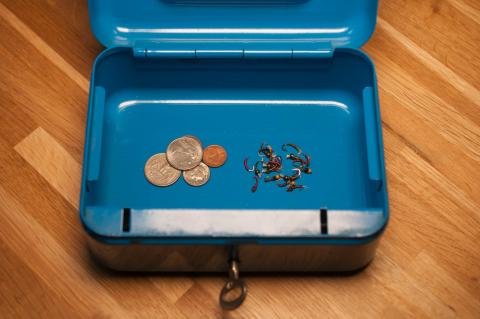Recent comments
Hello Martin,
my name is Kai Nolting and I was just listening to your padcast, while tying some flies for the coming seasen, dreaming of some seatrouts and that the spring now may still arrive.
I'm living in a city called Leverkusen near Colone in Germany and staying for two or three times every year in Danmark, flyfishing for seatrouts.
I think it's a very good idea to let us have some of your impression by speaking through the podcast.
So I say thank you while waiting for your next audio-turn and pictures. I hope to listen to a fight with a big seatrout next time.
Tide lines
Kai Nolting
- Log in to post comments
Excellent article. I have painted in the past so I have been using tiny artist brushes. I tried Q-tips as well. I have recently become obsessed with eyes on flies. These have been the stick on kind for hair bugs and divers that I glue on with some clear caulking or Goop. My streamers are about to become eyed. I think I have finally become a believer of eyes on flies. Like you say, they look good to us and it can't possibly reduce the number of fish you catch, so what the heck.
- Log in to post comments
Stephen,
Try clicking on the image... the picture is a part of an article, which tells you how to tie the fly...!
Martin
very nice fly! it would be nice to have the recipe. thanks
Edward,
Regarding the position of the indicator and problems with sliding. I have had the same experience a couple of times. Consider passing the top of the indicator twice through the loop. It will give an extra twist, but steady the ring on the line.
I have also used the indicators on knotted leaders where a knot will stop the indicator from sliding.
A smaller O-ring leading to a tighter loop might also do the trick.
Hope this helps.
Martin
- Log in to post comments
Everytime I try to use the "o" ring type indicators, they will travel down the line, i.e. not stay in the original position which negates their critical placement. Any suggestions on how to keep them in their original position?
- Log in to post comments
watch out the giant water bug has a nasty "bite" from what i hear, damn well should i guess they eat minnows.
- Log in to post comments
I have been tying and fishing "Micro Streamers" for years. I tye Wooley Buggers down to size 18 on 2x or 3x hooks when I can get them. They are very succesfull in winter trout fishing and early spring. I usually tye them with a few strands of silver crystal flash in the tail,
Alex Lilje
- Log in to post comments
The tubes can be plastic tubes, which can be found in many well stocked flyshops. I have also used cotton swabs. Trim off the cotton and you have a nice tube. Some are too brittle to work, but some are sturdy enough to last.
Martin
- Log in to post comments
Ed,
The elastic floss is nothing but thin, smooth rubber band on spools. I don't know the brand name, but I think Uni has something called UNI-Stretch, which is the same.
You could also varnish or epoxy the floss. That gives a great effect and makes your fly close to indestructible.
Martin
- Log in to post comments
The buzzer looks great and fished great even when I tied it with regular floss, which dosen't stand more than a couple of bites before getting loose ans ruining the fly. So, what is "elastic floss"? Where can I buy it online?
Thanks,
Ed
- Log in to post comments
This man does not look comfortable. Is this a vacation or work?
Thankyou, thankyou and thankyou. Just started in fly fishing for trout in the UK., and the more you read the more confused you get! Lots of magazine articles mentioning (to me) improbable leader lengths/tippets etc. A web-site that gives me answers until I know enough to make my own mistakes.
- Log in to post comments
Steve - I've enjoyed the write-ups on the caddis emerger and the midge. Keep up the good work. I live in Ft. Collins and fish the Poudre quite a bit. I'll tie some up and try them this season. Thanks.
- Log in to post comments
great looking fly. i can't believe how real it looks when wet. can't wait to try it out.
- Log in to post comments
Hey Guys,
Here are my replies:
Ryan: The BRB is one of my better fish catching patterns. It is one of my go-to patterns. Species caught are Rainbows, Browns, Cutties, Searun Cutties, Bulls, and Lakers. Species caught most often would be either Rainbows or Browns (probably due to water I fish most often). Other species caught include LM bass, SM bass, Bowfins, Perch, Walleye, and Pike.
Ed: Sculpin wool works great. My friend, Mike Dell likes sculpin wool. The lead eyes work well too. It is easier to use wool than deer hair if you decide to use lead eyes.
Brian: Hen works well too. I've always used saddle, because I tie lots of feather wing streamers and steelhead patterns. I also like saddle on my wooly buggers.
Cheers,
Alberta Al
- Log in to post comments
And Chris Helm markets one under the name "FlyTyer's Hot Point" (or at last he used to). I've had one of his for 5 years I think and I replace one battery at a time to ensure that the tip doesn't burn too hot.
Great tool - I use it mostly for kinking rubberlegs on nymphs and shrimps for my saltwaterfishing. If you want to try that, Martin, make sure you burn some power from the batteries - a glowing tip will sever a rubberleg before kinking it!!!
Lars
- Log in to post comments
I got one of Bedeschi's other books (Fly fishing Patagonia - The Lake Destrict). This is one of his earlier books in the nice landscape format.
Wonderful pictures (some were cropped from larger pictures so the sharpness is lost sometimes), the writing is mediocre at best. It's definately not the 'How & where to fish' book, but a nice coffee table book to show of to friends why fly fishing is more expensive than playing golf... ;)
- Log in to post comments
This pattern would be better adapted to Great Lakes Steelhead fishing if the tyer used a nickel plated, brass barbell weight on top of the hook. Use a holographic eye on the end of the barbell (grind down the rounded profile if necessary) and tie the entire pattern, upside down.
The barbell will cause the fly to ride, hook point up similar to a Clouser minnow.
The trick is to use this technique (pausing for a sip of Glogg) and create a fly that rides with the hook in a position so that when their is a strike, the fly lodges firmly in the corner of the mouth of your prey.
Also, try holographic silver tinsel on the body for more flash and sparkle. It will make the fly seem more alive.
BTW, I really believe in using a Mustad, downturned eye on this pattern. Because if you tie it as I have described the downturned eye uses the weight of the barbell to cause the hook to ride hook side up and will use the down turn as the flat stationary position from which the hook can be leveraged (again think fulcrum and lever) using the barbell.
Thats my two pence worth.
- Log in to post comments
Having worn the same pair of 5mm neoprene waders for nearly 15 yrs with only a few brush holes which i patched I was hesitant to give them up for breathables. I sent away to Cabelas for a pair, mostly for the guarantee but have been thinking about just spending $50 for a pair of 3 mm noprenes. The whole idea is how small they will or won't pack so my suitcase isn't just full of waders and boots. Any thoughts on light weight neoprene?
- Log in to post comments
Dear Martin.
I know very well what you say on Preben Torp Jacobsen: he was a great man!
I felt very much when they communicated to me his death now two years ago. Preben was a scholar of many topics related to the fishing to fly, between them the " Manuscript of Astorga "
Do you know who can be the owner of the original " Manuscript of Astorga?
As this summer I have thought to travel to Europe, if it could have in my hands this manuscript although I understand that this: it is a sleep!
Certainly Martin: do you know if the noble school of Preben Torp keeps on teaching the manufacture of canes of bamboo refundico and of artificial flies?
I have sent several e-mail to: flyleaves@mail.tele.dk and I have not obtained response. who is the new director of the school? do they have new e-mail?
Good Martin, I hope for your response, meintras receives an affectionate greeting.
Adriano
- Log in to post comments

